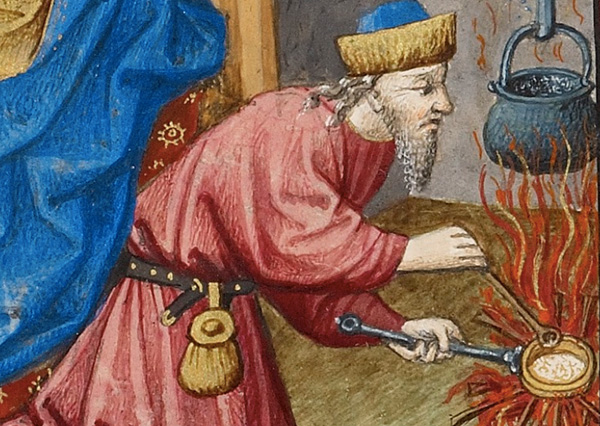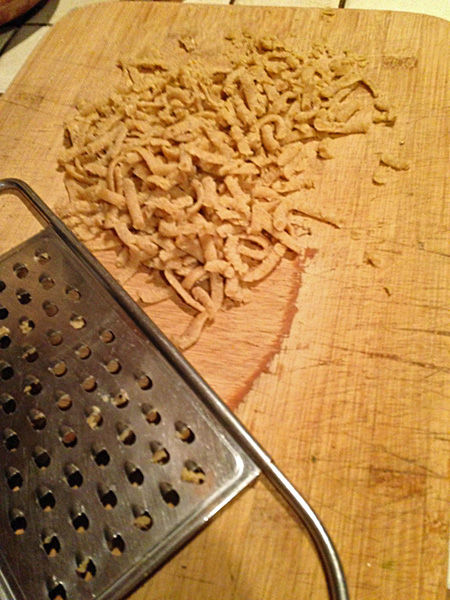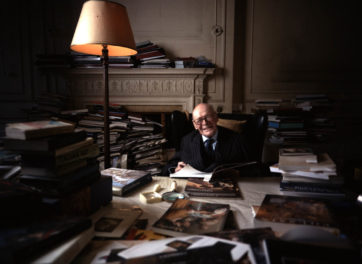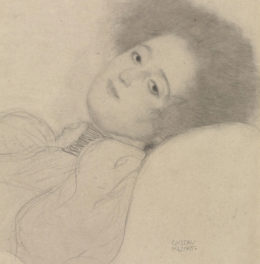
The Holy Family, about 1440-50, Workshop of the Bedford Master (French, active first half of 15th century). Tempera colors, gold leaf, gold paint, and ink on parchment; leaf: 9 1/4 x 6 7/16 in. The J. Paul Getty Museum, Ms. Ludwig IX 6, fol. 181
Here is a fascinating depiction of the Holy Family showing St Joseph preparing a meal for Mary while she breastfeeds the baby Jesus. A nursemaid stretches out her arms with a towel as if to receive the baby for a bath, presumably giving Mary time to eat.
 As is typical for illuminated manuscripts, it depicts a medieval rather than an ancient scene, in Bethlehem or otherwise—witness the clothing and the textile cloth of honor hanging behind Mary. Interestingly, it appears to take place outdoors with buildings in the back open on one side—seemingly suggesting a manger, though it may be intended to depict an upper-middle-class home.
As is typical for illuminated manuscripts, it depicts a medieval rather than an ancient scene, in Bethlehem or otherwise—witness the clothing and the textile cloth of honor hanging behind Mary. Interestingly, it appears to take place outdoors with buildings in the back open on one side—seemingly suggesting a manger, though it may be intended to depict an upper-middle-class home.
The text below reads, “Doulce dame de misericorde mere de pitie, fontaine de tous biens qui portastes….” (Sweet Lady of Mercy, mother of pity, font of all good, who carried….[Jesus Christ]). This is a standard prayer rather than a description of the scene.
Let us focus however on St. Joseph at the fire. Hanging from a rod is a standard medieval cooking utensil, the saw-toothed trammel. It looks fairly frightening, but is merely a simple device used to raise and lower the pot above the flame. A pole hooks under one of the saw teeth and supports it, here relatively far from the flame, probably containing a simmering broth.

The author cooking broth outdoors
St. Joseph also holds a rather elegant pan that appears to be made of bronze with an iron handle, hardly something one would have on hand in such a setting, but a prefered medieval cooking utensil nonetheless. He holds the pan much too close to the fire, crossing his arm over it with an awkwardly held spoon, as if about to stir the contents, though we should take this as merely the result of the artist’s skill and the limitations of the miniature form rather than intentional. The direction of Joseph’s back legs suggests that his body is impossibly twisted as well.
The artist seems simply to have wanted to show that Joseph is cooking while kneeling, which is perfectly typical for a medieval cook. This scene is also not unusual among medieval paintings. Conrad von Soest painted a similar scene in 1403, with Joseph blowing on a fire, cooking what looks like a very similar dish.

An iron pot with legs
Von Soest gets right that the proper pan for this job would have feet so it can hold itself above the fire. At the very least a spider trivet or even three bricks would hold the pan above the fire. Joseph in this manuscript is cooking by holding the pan itself over a way-too-hot fire, unless we are simply not shown the feet under the pan and directly in the flames.
What’s in That Pot?
What could he have been cooking? Some 16th-century stories describe Joseph cooking porridge for the Christ child. (See this article for a full discussion.) In this image, the artist clearly shows some squiggly things in the pan, and it is may not be too far a stretch to assume that he is making some kind of panada or chicken broth with eggs and bread crumbs, which was the most typical dish offered to convalescents, including women postpartum.

The logic was that they required something humorally hot and moist (sanguine) that would restore blood and build flesh, but that could also be easily “concocted” in the stomach and “assimilated” into the body according to current nutritional theory. In other words, something both nutritious and easy to digest. The chicken is in a sense predigested in broth form as is the bread in being baked, and eggs are always recommended as food for those with weak digestive systems. These ingredients, especially broths, concentrates, and wheat-based dishes, all form a category of foods considered “restorative” and from which we actually get the word restaurant.
But the squiggly things in the pot lead me to suspect that the preparation was a little more sophisticated than dumping ingredients in a pot and that these might be some form of noodle. (Perhaps wishful thinking on my part since I’m working on a book about noodle soup right now.) There are contemporaneous recipes though. A manuscript called the Liber de coquina includes a recipe for “tria ianuensis” (chapter 2, 66) or Genovese noodles. The word tria probably comes via Arabic itriya and ultimately Greek itrion, though whether the ancients actually had noodles is a matter of debate. They are definitely there in the late Middle Ages though.

Passatelli cooking in the pot
Other texts of this period also indicate that tria genovese are good for the infirm, for the very reasons indicated above. But how were they made? They could have been flour and egg, rolled out and cut, but there is a simpler procedure made of breadcrumbs, egg, cheese and sometimes other ingredients cooked in broth. These are now known as passatelli and look very much like what Joseph is cooking.

Preparation of passatelli noodles
These noodles are made of fine stale breadcrumbs with egg and Parmesan cheese (still believed to be eminently digestible) and sometimes a form of fat; experts agree that bone marrow is preferred. The trick to forming them is that you don’t need any other equipment apart from a large holed cheese grater.

Roasted bone marrow
The Opera of Bartolomeo Scappi in the 16th century illustrates one of these, not very different from those we use today. Scappi also, incidentally, has a whole section devoted to food for convalescents that, again, includes largely broths, pasta, and eggs. So I decided to replicate this recipe as a possible candidate for what Joseph is cooking for Mary. If you decide not to use an open flame like brave Joseph here, the results will be almost exactly the same.
Recipe: Noodles à la Joseph

Passatelli served
- Cut up a chicken and add to a pot of water with celery, carrots, parsnip, onion, and herbs such as thyme. Late medieval cooks also liked to add dried fruit and sugar. Leave to simmer as long as you possibly can on a low flame. This will be your broth, to be strained or simply later take some liquid leaving the solid parts behind.
- In a covered pan near, or better yet in, an oven, roast 2 small marrow bone sections from a shin of beef for at least 2 hours. Scrape out the cooked marrow.
- Mix one cup of stale breadcrumbs with a handful of grated Parmesan cheese and one egg, add the cooled marrow. Roll into a tight ball, adding more breadcrumbs until the ball is stiff but not too dry that it crumbles. Let rest for at least an hour or overnight.
- Take about 3 cups of broth and bring to a boil in a small pan. Take your ball of dough with the heel of your hand and force it through the holes in the grater, making small curved “noodles” or strings on a board.
- Being careful not to squash them, pour the noodles into the broth and cook 2 minutes. Transfer to a bowl with a large spoon.
Serves one Mother of Mercy.




Sounds like classic Jewish chicken noodle soup, which is quite appropriate.
Yes indeed, as a Jewish mother, she would know all about such things! Ken
I think Joseph is cooking scrambled eggs. This is the way I cook them…melt a little butter and a splash of half-fat milk into the saucepan to prevent the eggs sticking…hold the pan with one hand over a flame and stir constantly. When the eggs are congealing just right, remove from the heat and continue stirring whilst taking the mix to the plate. Now Mary can eat a nutritious, easily digested, filling meal, cooked carefully by her husband. Simple goodness for the Holy Mother.